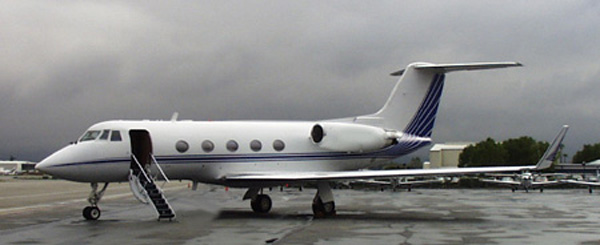 |
|
|
This guide addresses only the G II-B, not the G II or G III.
The G II-B is merely a G II that has been retrofitted with a G III
wing. It is a about two and a half feet shorter, and a bit lighter,
than a G III and is probably the best of the Pre G IV airplanes.
It generally costs about 2 million or so more than a G II, and between
three and five million less than a G III. The G III with the DC electrical
system is, except for being a little bit longer and heavier, about
the same as the G II-B. The windshield on the G III does make the
cockpit more quiet at high speeds. I have heard many times that Gulfstream
quit offering the G II-B retrofit because they feared it would have a damaging
effect on G III sales. Nobody will admit this, but it does make sense.
The G III with the AC electrical system is much electrically more like
a G IV. Of all the corporate aircraft I have flown, ( 22 Type Ratings
) the G II-B is my favorite. The Falcon 2000 is hard to beat,
but the Gulfstream is like a 67 Corvette 427 with dual quads and
a big cam. It goes like lightning, and creates it's own thunder.
 |
GOG II-B Mod & Serial Number Table
S t u d y G u i d e
|
|
Gulfstream II-B
|
|
|
|
|
|
|
|
|
|
|
|
|
|
|
|
|
|
|
|
|
|
|
|
|
|
|
|
|
|
|
|
Weights
| Max Ramp Taxi Weight
|
70,200 lbs |
| Max Takeoff Weight
|
69,700 lbs |
| Max Landing Weight |
|
| Max Zero Fuel Weight
|
44,000 lbs |
The above weights are maximum certificated limits. The actual maximum weights for a particular flight may vary due to the performance limitations. If the aircraft can not meet the required "Takeoff Field Length" and "Climb" limitations, (engine out climb performance), the maximum takeoff and/or landing weights are reduced such that the requirements are met. See the performance charts in the AFM for details.
Speeds
| Vmo / Mmo |
|
| Va |
|
| Vfe 10 Deg
20 Deg 39 Deg |
220 kts 170 kts |
| Vlo
Vle Emergency Extension |
250 kts / 0.70 Mach 175 kts |
| Vmcg
Vmca |
100 kts |
| Mach Trim Inop |
|
GO G II-B Vref Chart
GO G II-B Stall Speed Chart
Altitudes & Misc.
| Max Alt T.O. & LDG |
|
| Max Enroute Altitude
Max Altitude Flap & Gear |
20,000 ft |
| Min Temp T.O. & LDG
Max Slush Max Water |
0.75 inch 0.50 inch |
| Max Temperature
Abv 10,000 ft |
ISA +30 C |
| Min Temp SL - 3,500 |
|
| 3,500 - 5000 Linear |
|
| 5,000 - 10,000 |
|
| 10,000 - 35,000 Linear |
|
| Above 35,000 |
|
| Max Demonstrated X-Wind |
|
| Max Runway Slope |
|
| Max Tailwind Component T.O. & LDG |
|
| Load Factor Limit
Flaps Up Flaps Extended |
2.00 G |
Turn Clearance Limits
|
|
|
|
|
|
|
|
|
|
|
|
|
|
|
Spey Mk 511-8 Engine Limitations
|
|
|
|
|
|
|
|
|
|
|
|
|
|
|
|
|
|
|
|
|
|
|
|
|
|
|
|
|
|
|
|
|
|
|
|
|
|
|
|
|
|
|
|
|
|
|
|
|
|
|
|
|
|
|
|
|
|
|
|
|
|
|
|
|
|
|
|
|
|
|
Engine Oil System Limitations
| Min / @ Max Continuous |
|
| Min / Idle |
|
| Min To Complete Flight @ Max Cont. |
|
| Min To Complete Flight @ 92% N2 |
|
| Min To Complete Flight @ 84% N2 |
|
| Min To Complete Flight @ 52% N2 |
|
| Max Oil Temp |
|
| Max Transient Oil Temp / 15 Min |
|
| Min Oil Temp for Start
Min Oil Temp Above Idle |
-30 C |
|
|
The flight controls on the G2-B are cable driven with hydraulic boost.. They are powered by both the "Combined" and "Flight" hydraulic systems. Each of the systems provides 1500 psi to the flight control servo actuators. When the landing gear or flaps are extended, the combined system pressure increases to 3,000 psi. If one system fails, the remaining system pressure increases to 3000 psi. Failure of one hydraulic system therefore, does not result in a loss of control effectiveness.
Ailerons
The hydraulically boosted ailerons provide roll control. Either or both hydraulic systems will power the ailerons. They are assisted by the flight spoilers. A bungee connects the spoiler mixer and aileron on each side so that the ailerons and spoilers can be moved regardless of the status of the the other. Roll trim is provided by a trim tab located on the left aileron. The aileron trim tab is set with a manual trim wheel in the cockpit. No electric stuff here!
Elevator
The Gulfstream II-B is equipped with a moveable stabilizer, elevator, and elevator trim tab system. The elevator is hydraulically boosted. Elevator trim adjustments are made with the manual trim wheel in the cockpit, or electrically from the control yoke. The stabilizer is automatically adjusted when the flap setting is changed in order to compensate for changes in trim caused by flap extension and retraction. The stabilizer is moved via a gearbox in the tail. The flap gearbox is connected to the gearbox in the tail. The stabilizer position is indicated by a gauge within the flap position indicator. If the stabilizer does not position itself properly with each change in flap setting, return to the previous setting and go to the checklist. The aircraft may be landed safely with the stabilizer out of trim, however, much higher than normal control forces may be required, as the trim will not be as effective.
Rudder
The rudder, like the rest of the flight controls
on the Gulfstream, is hydraulic. Rudder trim is provided by redefining
the neutral position with the rudder trim wheel in the cockpit. The
maximum rudder travel is 22 deg each side of center. The rudder may
be trimmed 10 units, or 7.5 deg either side of center. The yaw damper
is a full time system, powered by the "Flight" hydraulic system.
It has 3 deg of authority each side of wherever the trim and pilot input
would place the rudder. If the "Flight" hydraulic system fails, the
yaw damper is inop.
The rudder on the G2B is equipped with a single
and a dual load limiter system. These systems limit the forces applied
to the rudder in order to avoid structural failure of the tail at high
speeds. This single rudder load limiter system limits hydraulic pressure
to a maximum of 2650 pounds to the rudder actuator to avoid excessive loads
on the aircraft at high speeds. The dual load limiter system further
limits the pressure to 2250 pounds. If only one of these two systems
is operable, and you have an MEL for the aircraft, you can fly.
The rudder load limiter systems have two indicator lights, an amber one
for the single rudder load limiter system, and a green one for the dual
rudder load limiter. Before start, the amber light should be on.
Only after both engines are running, the amber light will go out,
indicating that the single rudder load limiter system is working.
When the combined and flight hydraulic systems are operating, the dual
rudder load limiter may be checked. This is done by slowly depressing
one rudder pedal to the floor, and looking for a green light to illuminate
at full rudder deflection. Now press the other rudder pedal to the
floor, and the green light should illuminate again, indicating that the
rudder has reached it's mechanical stop, and the dual rudder load limiter
is in fact limiting the pressure. If you get the green light in one
direction but not the other, check the rudder trim and verify that it is
centered. If not, center it and repeat the test.
Flaps
The flap system is hydraulic. Flaps may be
extended to 10 deg, 20 deg, and 39 deg with the normal system. The
alternate flap control system can be used to extend or retract the flaps
to any setting between 0 deg and 39 deg. The flaps may be operated
by "Combined", "Utility", or "Aux" hydraulic systems. When the flaps
are moved, the horizontal stabilizer is repositioned via a gearbox depicted
below.
 |
|
|
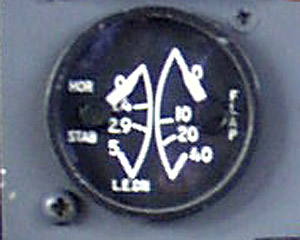 |
|
|
Because it changes the angle of incidence of the
horizontal stab, it minimizes trim changes during flap extension and retraction.
Flap asymmetry protection is provided via electrical signals from the outboard
flap jackscrews. The flaps system will stop if there is 1/4 inch
or more difference in the linear travel of the flap actuators. A
torque limiter prevents damage to the system in the event of a jammed mechanism
or an attempted extension at excessive airspeed. A flap assymetrey
will not reset until it is fixed. If flap movement is arrested, it
is either loss of hydraulics, flap assymetry, or torsque limiting.
If it was torque limiting, slow the airplane down to within the limiting
speed for the flap setting you tried to get. Retract the flaps to
the previous setting, then re-extend at the proper airspeed. If this
restores flap operation, it was in fact the torque limiting system just
doing it's job. The airplane flies just fine if you stay clean until
around 200 knots. Extending the flaps at less than the limiting speeds
will minimize the unwanted pitch activity during flap extension.
In the event of unwanted flap movement, the flaps
may be stopped, and the flap selector disabled by a switch on the copilot's
lower arm ledge. With this switch activated, the flaps are moved
by the emergency flap control. Any setting between zero and full
may be selected. You still have flap asymmetry protection in the
emergency mode.
Max Flap Extension Speeds
|
|
|
|
|
|
|
|
|
Flight Spoilers
All G2's and G3's have six spoiler panels on the wing. They are referred to as 4 and 6 panel systems. This addresses the fact that on the "4 panel" airplanes, the inner two panels only extend when ground spoilers are deployed. The outer 4 panels extend when speedbrakes are selected, and all extend in the ground spoiler mode . The "6 panel" airplanes use all of the spoiler panels in flight, but only extend them to 26 deg as opposed to the 43 deg deployment on the 4 panel system. Entering a turn, the spoilers on the lower wing will extend to 55 degrees in conjunction with full aileron and speedbrake deflection. The first 11 of the 43 G2 B's have 4 spoiler panels. Mod Numbers 12 thru 43 and most of the G3's have 6 spoiler panels. The Flight Spoilers / Speedbrakes are powered by both the "Combined" and "Flight" hydraulic systems. Speedbrakes may be extended with up to 20 deg of flaps. Spoiler / Speedbrakes may not be deployed in flight with the flaps more than 20 deg, or with the Landing Gear extended. The Flight Spoilers also assist in roll control, as they operate selectively with the ailerons. A bunge allows aileron movement in the event the spoiler is stuck.
Ground Spoilers
The ground spoiler system uses the same spoiler panels as the flight spoilers. It merely extends them to 55 degrees, instead of the 26 degrees available in flight. The ground spoilers may not be armed without a successful nutcracker test after gear extension. G II-B Modification numbers 1 thru 11 are four panel airplanes. Mod. Nos. 12 thru 43 have the six panel system. There is an easy way to figure out if you have a four or six panel airplane without knowing the modification number. The six panel airplanes do not have a ground spoiler deact handle. They did not move it, it just ain't there!
Four and Six Panel Spoiler / Speedbrake Systems
|
|
|
|
| Max Aileron
0 Speedbrake |
|
|
| 0 Aileron, Max Speedbrake |
|
|
| Max Aileron
Max Speedbrake |
Up wing 43 deg |
Others 26 deg |
| Auto Ground Spoilers |
|
|
Nosewheel Steering
Ground steering is provided by a hydraulically actuated steerable nosewheel. The nosewheel may be steered 82 degrees each side of center. The nose steering is powered by the "Combined" or the "Utility" hydraulic systems. In the event those systems are inop, differential braking may be used for directional control on the ground. In order to use differential braking to steer, you must turn the nosewheel steering system off. This is done with a red guarded switch located just forward of the tiller. The nose steering system is disabled unless the nut crackers are in the ground position. Loss of Main DC Bus power has the same result as turning the nosewheel steering system off.
Brakes
The normal braking system provides braking with all of the main gear wheels. The main wheel rotation is arrested during gear retraction. The combined hydraulic system provides 250 pounds of hydraulic pressure to the brakes during the gear retraction cycle in order to stop the rotation of the main wheels. An anti-skid system provides skid protection during braking with the normal system. This includes protection if the brakes are applied prior to touchdown. Anti-skid does, however, require Main DC Bus power. The parking / emergency brake is powered by an accumulator. Use of the emergency brake system usually blows the tires, as it is almost impossible to modulate, and locks the main wheels.
Autopilot
Gulfstream II SN # 1 thru 238 (except 220)
were delivered with the Sperry SP-50G autopilot. The SPZ-800
autopilot was installed on # 239 and later. In this guide, we will
address the SP-50G. The SPZ 800 will be discussed in the G III study
guide. The SP 50-G is the older of the two systems, and was a commonly
installed in the Boeing 727-100, and earlier 727-200 airplanes. It
is a great system even today, It can even be certified for
MNPS and RVSM if the appropriate mods are done the the aircraft..
It provided all of the basic autopilot functions such as wing leveling,
heading hold, NAV and will intercept and fly an ILS approach if properly
set up by the crew. Altitude preselect is an option, but should be
found on most G II-B's.
Do not engage "Manual Glideslope" unless you are
within a quarter of a dot of on glidepath. Although it is not a limitation,
if you are more than half a dot away from dead center on the glide path
it will capture, but you and your passengers may not like that portion
of the ride. Avoid the same mistake on your next job! Manual
Glideslope is normally used to capture the glideslope from above.
If you are intercepting from below, AutoGS is a much better idea.
Unlike many of the crude autopilots of it's day,
the SP-50 works well in the IAS and Mach speed modes. It does, however,
lack a half bank mode. It is a bit on the aggressive side when capturing
a new course at a waypoint change. For passenger comfort, switching
to heading mode until established on the new course may work better.
The SP-50G is not integrated with the flight director system.
 |
|
|
|
|
| Above Vmo/Mmo |
| Below 1.2 Vs |
| Below 38,000 lbs and aft of 43% MAC CG |
| With Yaw Damper Inop |
| Above 35,000 ft with an engine inop. |
| With Autotrim inop |
| During coupled approaches with an engine inop |
| During takeoff or landing |
| Do not SELECT Manual Glideslope below 1,000 ft AGL |
Although it is not a limitation,
it is highly recommended that you not select Manual Glideslope if you are
more than half a dot away from dead center on the glide path. It
will capture, but you and your passengers may not like that portion of
the ride. Manual Glideslope is normally used to capture the glideslope
from above. If you are intercepting from below, Auto is a much better
idea.
|
|
All of the Gulfstream II and III aircraft are powered by two Spey Mk 511-8 engines. These engines produce 11,400 pounds of thrust each. The Spey Mk 511-8 is a twin spool axial flow Jet Engine. The LP compressor, (N1 or Fan) is a 5 stage compressor. Some of the air from this LP compressor is routed around the engine core, and provides thrust. The rest of the LP air is ingested into the HP or N2 compressor. The N2 section has 12 compressor stages. Behind the compressor sections is the combustion chamber, then the HP turbine, and finally the LP turbine. The HP and LP turbines drive their respective compressor sections.
Percent vs RPM
|
|
|
|
|
|
Accessories mounted on the engine include oil pumps,
high pressure fuel pump, a hydraulic pump as well as alternator and generator
for each engine. These are driven by the HP or N2
section. The engine oil is cooled by fuel via a fuel / oil heat exchanger.
It heats the fuel and cools the oil. Oil pressure indications are
provided by an AC powered gauge and a DC powered low pressure light (Idiot
Light) for each engine. There is an engine oil replenishing system
installed on Gulfstream Jets. Engine oil may be serviced only on
the ground.
Variable inlet guide vanes, and farther back, a
surge bleed valve on the 7th compressor stage are installed to stabilize
the engine idle, prevent compressor stalls, and optimize the engine acceleration
characteristics. A malfunction of the surge bleed system will result
in unstable idle, poor acceleration, and compressor stall in many instances.
 |
|
|
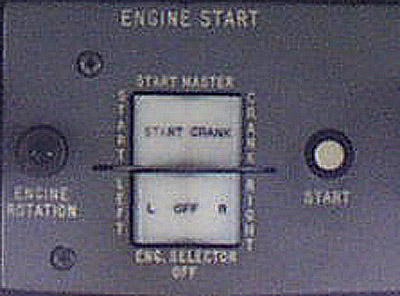 |
|
|
TVI
Vibration is monitored in the engine with the TVI
or Turbine Vibration Indicator system. This system allows the crew
to monitor the engine vibration. This can alert the crew of impending
malfunction or failure of the rotating engine components. Some vibration
is normal, however a change in vibration level may indicate impending doom
for the engine. See the chart below.
|
|
|
| Increase of 1.0 or more during steady state operation | Slowly close thrust lever & observe vibration during deceleration. Make an note of the maximum value. If less than 3.0 (3.5 between 67% and 74% N2), restore power and monitor engine instruments. |
| A sudden increase of 3.0 (3.5 between 67% and 74% N2) | Perform engine shutdown if situation permits. Monitor engine warning systems. |
| During start, Increase of 3.0 or more. | Abort the start. |
| During shutdown, Increase of 3.0 or more. | Record incident and have engine inspected. |
Fuel Heat
An automatic Fuel Heating system is installed on these engines. This is to prevent any ice formation in the engine fuel system. The fuel is heated by P3 bleed air, and monitored by fuel temperature gauges in the cockpit. These gauges are powered by the essential DC bus. Some fuel heating does result from the fact that the hydraulic systems have heat exchangers in the hopper tanks, however the intent of these is to cool the hydraulic fluid. The fact that the fuel is heated a small amount is not important.
Top Temp Control
A temperature control and limiting system is installed
on the Spey 511 Mk-8 engine. This system, if on, will prevent a TGT
overtemp. The temp control amplifier is powered by the 115 Volt AC
instrument Inverter Bus. The Top Temperature Control System is to
be ON except in the event the system fails.
|
|
The great thing about the APU on the Gulfstream is
that it will allow you to start the engines and go someplace, instead of
just sitting on the ramp. The APU on the G2 is for ground operation
only. It can provide air for engine start, or air conditioning, as
well as AC electrical power. Some of this AC may be converted to
DC with the Emergency TR. The DC can then power the inverters, providing
constant frequency AC. So, in a round about way, the APU can power
the entire airplane on the ground. If you have the 300 Amp TR, you
have plenty of DC for the task, unless you get stupid with an excessive
number of boost pumps and landing lights.
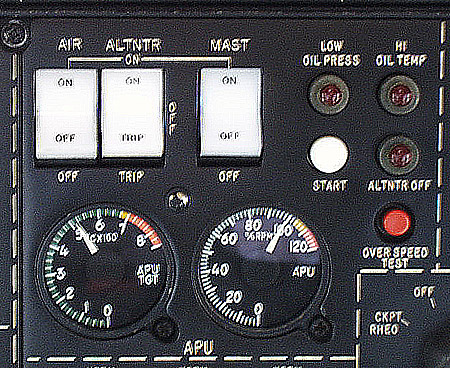 |
|
|
To start the APU, turn on the APU Master Switch.
Wait for the Low Oil Pressure light to illuminate, indicating that the
APU door is open. Press and release the start button, and wait.
When the APU RPM is stable at 100%, turn on the Alternator. Check
that both AC busses are powered, then select the Emergency TR Main &
ESS. The ESS only position is primarily for use in flight for split
buss operation. Caution: Do not open the APU
air valve unless the Main DC Buss is powered. Doing so will result
in a very quick overheat of the bootstrap unit, as the control for the
ground cooling fan is on the Main DC Bus. If the Main DC Bus is not
powered, the ground cooling fan will not come on.
Check that the DC Volt Meter reads 26 Volts.
The DC Emergency Feeder light should be illuminated, indicating that the
emergency TR is powering the Main and Essential DC Busses.
The APU Air must be turned on if you wish to do
anything really festive, like start the engines or use the heating / air
conditioning system. Do not run the engines much above idle with
the APU Air Valve Open, as this is not good for the APU.
To shut down the APU, turn off the Air and Alternator,
let the temperature stabilize, then press and release the "Overspeed" test
switch.
Note: Performing a "Nut Cracker" test with the APU
running will shut it down, as the APU will think that the airplane has
just become airborne. I learned this from experience. The bright
side is that I was the only occupant of the aircraft at the time and therefore
did not have to explain my mistake. The APU is a ground only item
on the G-II aircraft. This remains true even if the 36-100 APU is
installed. The GTPC36-100 is certificated for operation in flight
on the later G III's, but not on any of the G II's.
|
|
Engines / APU
The engines and have continuous wire fire detection
loops in the engine compartments. When heated to their alarm value,
they will cause the engine fire warning system to activate. The respective
left or right ENGINE FIRE lights will illuminate. On # 173 &
Sub and aircraft with ASC 152, fire bell will sound. Press
the "Fire Bell Mute" button to cancel the bell. The fire may be extinguished
by pulling the respective fire handle, and discharging one or both of the
engine fire bottles. Their are two engine fire bottles, each containing
4.5 pounds of Bromotrifluromethane and about 600 psi of nitrogen
to disburse it. Either or both bottles may be discharged into the
selected engine.
 |
|
|
The APU fire warning is provided by a thermal switch. The APU fire bottle is like the engine fire bottles, only smaller. It contains 2.5 pounds of the extinguishing agent, and the 600 psi nitrogen to distribute it. The APU fire bottle may be fired by lifting the guard and moving the switch. Any fire bottle that is discharged must be removed from the airplane, serviced, and reinstalled. The engine and APU fire detection systems are not part of the Master Warning System.
Note: If you get a fire warning, and perform the appropriate procedure, test the fire detection system after you believe that the fire has been extinguished. If the system won't test, the fire detection loop may have been damaged. In this case, you don't really know if the fire was actually extinguished.
Electrical
Overheat warning is provided for the generators, alternators, TR's, radio rack, and inverters. Some of the warning lights serve two items, such as a TR and an Inverter. These require some diagnosis. Refer to the checklist. The E and B inverters and the B inverter's TR have an auto shutoff feature, as they are located in the radio rack inside the airplane. When the B Inverter shuts down due to an overtemp, it also pops the breaker for the bus it was powering. If one bus caused both it's own inverter and the B Inverter to overheat, the problem is most likely on the bus.
Hydraulic
Overheat warning is provided for the Flight and Combined, systems, and the Aux hydraulic pump. These systems do not incorporate any automatic features to deal with the problem. Consult the checklist for the appropriate procedure.
Pneumatic
The wings, tail compartment, bleed air manifolds,
aft compartment, and bootstrap unit are equipped with overheat warnings.
On the ground, the bootstrap unit will shutdown automatically in the event
it overheats. In flight, the bootstrap unit will only give you a
warning, and must be shut down by the crew. Selecting either Emergency
Pressurization or Ram Air will shut down the bootstrap unit. Emergency
pressurization air is available from the LP compressor on the right engine.
The remainder of the warnings must be handled by the crew.
|
|
The G II-B Fuel System is simple. Fuel is stored
in the wings. Each wing tank has a "hopper" tank that is kept full
with ejector pumps and gravity. Four DC electric fuel pumps provide
fuel pressure to the engine driven fuel pumps. Warning lights will
illuminate when the hopper tank has 675 pounds of fuel or less. This
amounts to between 20 and 25 minutes at 200 knots IAS at 5000 MSL, or about
50 miles to dry tanks.
Two of the fuel pumps are designated as "Main",
and two as "Alternate". They are in fact identical. They are
located in the main wheel wells. Normally, all four pumps are on.
If one pump on a given side is turned off, the other pump can supply ample
pressure. In the event that the operating pump fails, and the failed
pump's switch is in the on position, the other pump on that side will come
on. The main fuel pumps are powered by the ESS DC bus. The
alternate fuel pumps get there power from the MAIN DC bus.
You may supply fuel to either or both engines from
either tank by opening the crossfeed valve and switching the fuel pumps
off on the side from which you do not wish to feed. An intertank
valve is also installed, allowing fuel to gravity flow between the tanks.
Mod Nos. 9 and subsequent
or 1 thru 8 with ASC 252
|
|
|
|
|
|
|
|
|
|
|
|
Mod Nos. 1 thru 8 without ASC 252
|
|
|
|
|
|
|
|
|
|
|
|
 |
|
|
The airplane burns about 5,000 lbs the first hour,
3,500 lbs the second hour, 3,300 lbs the third hour, then 3,000 lbs per
hour thereafter. Low altitude holding requires 4,000 lbs / hour fuel
flow. This gives you about 8 Hours range with 45 minutes of holding
fuel.. This will take you more than 3,200 nautical miles at
normal cruise. Use of long range cruise will result some additional
flight time. I know of flights of over 8 hours duration that landed
with legal fuel reserves. Initial cruise altitude should be FL 370
to FL 390 if you take off full. The airplane will go higher, in fact,
all the way to FL 450, but does not like it up there for the better part
of an hour. Mach 0.75 is about all it will do for a while.
The G II-B is quite an airplane. Thank God it has a bathroom.
|
|
The Gulfstream II-B hydraulic system uses skydol. It has two engine driven pumps, an electric aux pump, and a utility pump that is driven by the "Flight System". This "Utility Pump" is a hydraulic motor, (driven by the flight system) connected to a hydraulic pump that can pressurize the "Combined System" except the flight controls in the event that the combined system pump, or the left engine were to fail. There is no fluid transfer between the flight and combined systems. If the failure of the combined system includes loss of the fluid, the utility pump will not have any effect, as there is nothing for it to pump! The combined and flight hydraulic systems have heat exchangers located in their respective fuel hopper tanks in order to cool the hydraulic fluid. These have nothing to do with the "Fuel Heat" system which is located in each engine's nacelle.
Combined System
The "Combined System" is powered by a hydraulic
pump on the left engine, or in the case of Combined System pump,
or engine failure, the Utility Pump. The utility pump is driven by the
Flight System. The electric "Aux Pump" can power 5 items only.
See the chart below. Combined pressure goes to 3000 psi when the
gear or flaps are extended.
Flight System
The "Flight" System" is powered by an engine driven
hydraulic pump located on the right engine. It's normal operating
pressure is 1500 PSI. It will operate at 3000 PSI if the combined
system pressure drops below 800 psi. This is to increase the pressure
to the flight controls, and to enable the flight system to power the Utility
Pump.
Utility Pump
The Utility pump is a hydraulic pump that pressurizes
the Combined System, except the flight controls when it's own pump is not
putting out sufficient pressure for whatever reason. Operation of
the utility pump requires at least 2,200 psi flight system pressure.
The Utility pump can drive all of the combined system items except the
ailerons, elevator, rudder and flight spoilers. In the event it is
necessary to use the utility pump, those items are operated by the flight
system. If the flight system does not work, the utility pump won't
work either, as the utility pump is driven by the flight system in the
first place!
Aux System
As you can see from the table below, the aux system,
in normal operations, is used on the ground. It allows you to extend
and retract the landing gear doors during the preflight, closes the cabin
door, and provides pressure so you can set the parking brake. It
also operates the Flaps and Brakes on the ground or in flight.
 |
|
|
|
|
System |
|
| Ailerons | Ailerons | |
| Elevator | Elevator | |
| Rudder | Rudder / Yaw Damper | |
| Flight Spoiler / Speedbrake | Flight Spoiler / Speedbrake | |
| Ground Spoilers | Ground Spoilers | |
|
|
Right Thrust Reverser | |
|
|
Utility System Motor | |
| Ground Spoilers | <<<--- | *Right Thrust Reverser |
| Nose Steering | <<<--- | Flight Sys Reservoir Press. |
| Thrust Reverser(s) | <<<--- | |
| Stall Barrier | <<<--- | |
| Windshield Wipers | <<<--- | |
| Combined Sys Reservoir Press. | <<<--- | |
| <-Aux Pump | ||
| Landing Gear | <<<---Note: Gear on ground only! | |
| Pedal Brakes | <<<--- | |
| Flaps | <<<--- | |
| Parking Brake | <<<--- | |
| Cabin Door (Close only) | <<<--- |
* Aircraft # 123 thru 163, 166 thru 190, 193 thur 198, and those aircraft with ASC 138. On other aircraft, the thrust reversers are both powered by the combined or utility hydraulic systems.
Note: Use of the Aux Pump to operate the Landing
Gear on the ground applies to the landing gear doors only. The gear
doors are opened on the ground for preflight, and to keep condensation
from accumulating in the main gear doors. If you leave the airplane
in an environment where the temperature goes below freezing, any water
that may be in the main gear doors can freeze, and may interfere with landing
gear operation if it remains during gear retraction, or cause damage on
the ground if a chunk of ice falls out and hits something.
|
|
The electrical system on the Gulfstream II-B may look complicated at first glance, but it is not. It consists of 2 batteries, two 300 amp DC generators, and two variable frequency (wild AC) 115 Volt 20 KVA alternators plus an APU alternator of the same capacity. Not counting the APU alternator, because it can't be used in flight, the Gulfstream II and II-B have 2 DC generators and 2 Alternators. Also they have 4 inverters to make consstant frequency AC from DC, and 4 Transformer / Rectifiers to make DC from AC. The bottom line is, as long as you have at least one of the four electrical generating devices operational, you will have at least the minimum electrical power needed to fly the airplane. In the Gulfsteam, one out of four ain't bad!
Overview
In general, the DC system powers most of the electrical
components on the airplane. The alternators provide power to heat
the windshields, power some interior lighting, and to power the TR's
that produce the DC that powers the inverters. It may sound complicated,
but a peek at the electrical schematic will make it a bit less confusing.
The inverters supply the 400 hz AC that is needed by the gyros, avionics,
and flight guidance system. The "E" (instrument) inverter is powered
by the ESS DC bus. It is only needed when the Main Inv. Bus is not
powered by the A or B inverter, or by the left generator tie bus through
the use of the Inv Alt Pwr, or "Skip" switch. The "A" and "C"
inverters are powered by their respective TR's, but can also be powered,
if desired, by the DC system through the use of the INV ALT PWR switches.
These are also refereed to as "Skip" switches.
The Emergency TR is powered by the left alternator
bus. This bus should be powered if any one of the three alternators
is operating. The emergency TR can power the ESS DC bus, and both
the MAIN and ESS DC busses as desired. When the airplane is on the
ground without the engines running, the ESS TR powers the DC system.
This is normal.
Constant Frequency AC System
The constant frequency AC system is controlled by
the switches below. Each AC bus has it's own 3 position switch.
Normal, Off, and Standby or Emerg. are the switch positions. With
all three switches in NORM, the A inverter powers the Main and INST Inverter
Busses, the C inverter powers the Secondary INV bus, and the B inverter
powers nothing. As long as the A or B inverter is powering the Main
Inv. Bus, the Main and Inst AC busses can almost be considered one bus,
as they are connected. This remains so as long as either the A or
B inverter is powering it. If, however, the E inverter is powering
the Emergency Instrument Bus, the relay between the two busses opens and
the E inverter powers ONLY the Instrument Inverter Bus.
If the main or secondary inverter bus switch is selected to standby, the
B inverter powers that particular AC Bus. The B inverter can power
the Main OR the Secondary AC bus, never both at the
same time. If both the Main and Sec bus switches are in standby,
the Main gets the power.
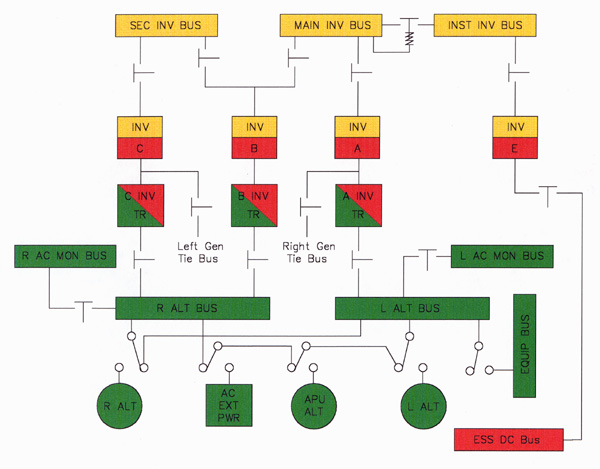 |
|
|
AC
Variable frequency AC is provided by the two ships alternators,
and on the ground only, the APU alternator. Constant frequency AC
is provided by converting the variable frequency AC to DC, with a Transformer
/ Rectifier or "TR". The then "TR's" DC output powers inverters
that produces the constant frequency AC. There are four inverters
in this system. The "E" inverter can power only the Instrument AC
Bus. The "C" Inverter powers only the Secondary AC Bus. The
B inverter can power the Main, or Main and Instrument AC Busses, OR
it can power the Secondary AC Bus, but not both. The A inverter can
power the Main AC, or the Main AC and the Instrument AC busses. The
E and B inverters are in the radio rack, and have thermal protection that
will shut them down if they overheat. The A and C inverters have
overheat warning lights, but no auto shutdown protection. If the
TR's feeding the A or the C inverters fail, those inverters may be powered
by the DC system through the use of the "Skip" switches. The inverters
overheat warning tells you that the respective inverter or the "TR" has
overheated. Switch inverters and let things cool for a minute, then
if you wish to diagnose the problem, turn the inverter back on and use
the "Skip" switch. If the fault does not recur, it was most likely
the "TR", and if it does, it was the inverter that was the problem.
 |
|
|
GOInverter
/ Constant Frequency AC Bus Check
DC
DC is supplied by either or both of the DC generators,
and / or by the Emergency "TR". The Emergency "TR" is powered by
any one of the ships alternators through the left alternator bus.
The DC power is distributed by two busses, Essential and Main. Loss
of one DC generator is not a problem, as you merely revert to "Split Buss"
operation to reduce the load on the remaining generator.. Place the
TR switch to ESS, and Bat switch to Emergency. Now, your remaining
DC generator powers the main DC Bus. The Emergency TR powers the
Essential DC Bus, and keeps the batteries charged. The Emergency
TR is powered by the left AC bus. When you select the Emergency
TR, the left AC equipment bus becomes unpowered as indicated in the previous
electrical schematic.. Operation of the Emergency TR is illustrated
below. With the failure of both DC generators, and at least one alternator
on line, the Ess DC Bus can be powered by the Emergency TR. You can
also power the Main DC Bus, but be cautious not to overload the TR or the
alternator. The 300 amp TR is not installed on all airplanes, and
the alternator is limited to 53 amps for continuous operation.
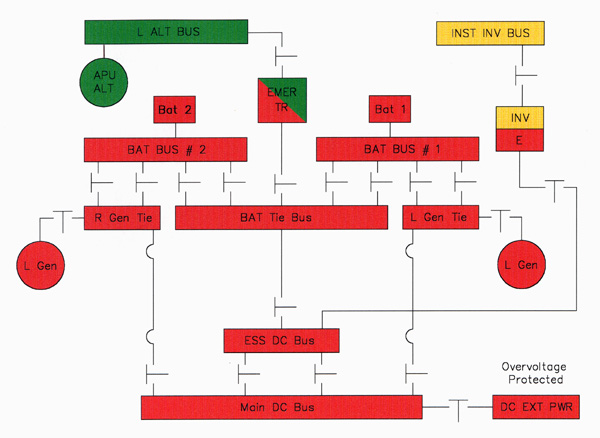 |
|
|
 |
|
Normal during Ground Operation |
The Emergency TR can power the Ess DC Bus, or both the Ess and Main DC Bus, as selected by the crew. The 200 Amp Emergency TR needs a bit more monitoring when the batteries have been drained a bit. Disconnecting one battery reduces the load on the TR by as much as 50 to 100 amps.
GO
Battery Integrity / DC Systems Check
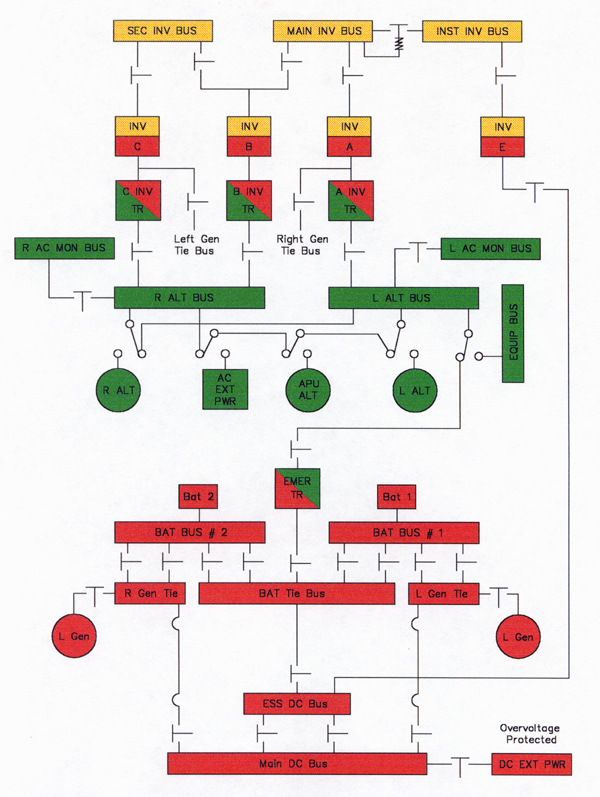 |
|
|
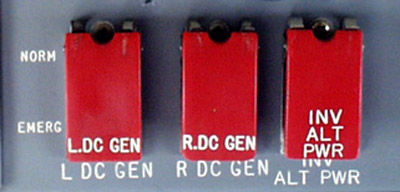 |
|
|
ASC 165 - On # 001 - 155 powers inverter control circuits from
ESS DC instead of MAIN DC.
# 156 & sub are that way from the factory.
ASC 151 - On # 001 - 155 Installs INV ALT Power or "SKIP" switches.
This enables you to power
the "A" inverter from the from the R GEN tie bus, or the "C" inverter from
the L GEN tie bus.
# 156 & sub are that way from the factory.
One Generator & One or both Alternators Operating
Split the bus! Battery switch to Emergency, TR switch to Essential. ESS DC Bus is powered by the TR, and the Main Bus is powered by the remaining generator. Load on the operating generator is reduced. The inverters are powered normally. All busses are powered except the AC equipment bus which is lost whenever the emergency TR is in use. If one alternator is inop, the AC monitor buses will be unpowered as well.
One Alternator & Both Generators Operating
No action required; The alternator busses get power from the opposite alternator bus when their own alternator fails. The AC monitor busses will not be powered. Monitor the alternator load. Windshield heat is a high draw item. In non-icing conditions, it can be shed if speed altitude and humidity permit. One of the inverters may be powered by the DC system through the use of the "Skip" switch if AC load reductin is desired.
One Generator Operating & Both Alternators Failed
Monitor the load on the remaining generator. Inst. Inv. Bus is powered by the E inverter. You will have at least the Essential DC Bus and depending on the DC load, the Main DC Bus as well.
One Alternator Operating & Both Generators Failed
Battery switch to Emergency, TR switch Essential. ESS DC Bus is powered by the TR. If the load on the generator permits, the main DC bus may be powered. The inverter system should operate normally.
Electrical Capacities
| Alternators |
58 Amps / Emergency |
| DC Generators |
|
| DC Brushless Generators
ASC 285 |
Single Gen. Operation 28 Volt / 250 Amp |
| Emergency TR / Standard |
|
| Emergency TR / Optional |
|
| APU Alternator |
|
| Batteries 1 & 2 |
|
|
|
The Gulfstream II-B is certified for flight into known or forecast icing conditions. We will discuss the various Ice and Rain protection devices system by system. The vertical and horizontal stabilizers do not require ice protection. This was determined by flight testing during the aircraft's certification process. All of the Gulfstream's anti-ice systems are powered by the Essential DC system.
Engines
The engine inlet hub fairing, inlet guide vanes,
and the nose cowl are heated by engine bleed air in order to prevent ice
formation. The air is controlled by two engine anti-ice valves located
on each engine. They are powered by Ess DC, and fail to the closed
position. These valves are opened and closed with the "ENG. ANTI-ICE"
switches. Each valve has a separate circuit. To determine if
one anti-ice valve has failed to open, compare the engine anti-ice duct
pressures. The engine EPR pitot probes are heated electrically heated when
engine anti-ice is selected on. On aircraft with ASC 111, the EPR
pitot probes are heated when the Pitot Heat switch is on.
If the anti-ice duct pressures are the same at equal
rpm, they are OK. If they differ by 15 psi or so, and one is below
45 psi, one valve is probably failed closed. If the pressure is more
than 60 psi, a valve has more than likely failed open. These valves
fail to the closed position when Essential DC power is lost.
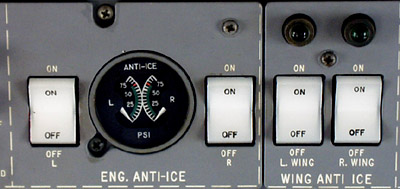 |
|
|
Wings
The wing leading edges are heated with engine bleed
air in order to prevent ice formation. Wing heat is controlled with
two "Wing Anti Ice" switches. Each of theses switches controls it's
respective wing anti-ice valve. This does not mean that you may heat
one wing and not the other. The bleed air ducting downstream of the
wing anti-ice valves is connected by a crossover manifold such that either
Wing Anti Ice switch being turned on heats both wings.
After activating the wing anti-ice system, the wing
leading edge begins to heat. When the respective wing temperature
reaches 100 deg F, the that wing's green light above the Wing Anti Ice
switches will illuminate, indicating normal operation. The temperature
is automatically regulated. If the wing anti-ice controllers fail,
and the temperature reaches 180 deg F, a red L or R WING HT light will
illuminate. You must then turn one or both wing heat switches off
as necessary to extinguish the warning lights. The entire wing anti-ice
system is useable during emergency DC operation, as the CB's are on the
Essential DC Bus.
Windshields
Rain removal is performed with hydraulically powered windshield wipers. The windshields are heated electrically. When the windshield heat switch is placed in the "ON" position, the windshields receive electrical power from the "Right Alternator Bus". This bus can be powered by either of the ships alternators, or the APU alternator if it is operating. The AC power on the Gulfstream is 3 phase. Without going into lots of detail, three phase alternators behave like three alternators, providing 3 wires, and an electrical ground. The first "Phase", or "A Phase" powers the captain's windshield. "B Phase" powers the copilot's windshield, and "Phase C" powers all the side windows as well as the "DV" window. The front windows have temperature sensors that provide the temperature controllers with the information necessary to regulate the amount of power to the windshields, thus controlling the windshield temperature. The front and DV windows have green annunciator lights that will advise you when the windshields are powered. The side and DV window temperature is controlled by thermal switches. There are no annunciator lights that address the side windows.
Pitot-Static & AOA
The pitot tubes and the angle of attack probes are electrically heated. The left form the ESS DC Bus, and the right from the Main DC Bus. When engine anti-ice is on, the EPR pitot tubes are also heated if ASC 111 is installed. Depending on the mod status of the airplane, you will have:
|
|
|
|
|
|
|
|
Pressurization
The cabin is pressurized with HP bleed air from the N2 compressor section of each engine. If the air-conditioning unit (boot strap) fails, emergency pressurization may be selected. This provides air from the LP or N1 compressor section of the right engine. The pressurization is regulated with one of two outflow valves. The normal outflow valve is electrically operated. It is AC powered in the "Normal" mode, and DC powered in the " manual mode. The second outflow valve is a "Safety Valve", requiring no electrical power whatsoever. This valve provides relief at maximum pressure differential, and vacuum relief, as well as a pressurization rate limiter.
During normal operation, before takeoff, you set
cruise altitude, barometric pressure, destination field elevation and cabin
rate. The system does the rest. Change the barometric pressure
setting if appropriate, and at top of descent, move the switch from "Flight"
to "Landing".. That's it! If manual mode is required, move
the outflow valve as necessary with the manual (DC electric) system.
Go easy, as the valve moves quite fast. A general announcement to
the passengers may keep you from looking like a dummy!
 |
|
|
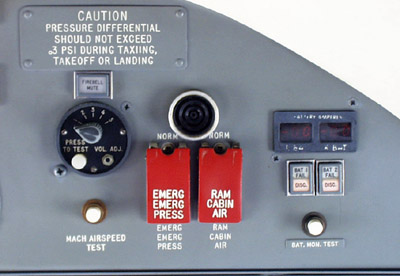 |
|
|
Emergency pressurization air comes from the LP bleed port on the right engine. Selecting RAM CABIN AIR closes the air-conditioning valve, causing the airplane to depressurize. Once the cabin has depressurized, the ram air valve opens to ventilate the cabin.
Air Conditioning
The same air that pressurizes the airplane
also provides air conditioning and heating. What a surprise we have
here! The engine bleed air is quite hot, up to 900 deg F when
it comes out of the HP port, and about 400 deg F once it passes through
the precooler.. In order to cool it, there are heat exchangers in
the engine pylons, and a "Boot Strap" unit to further cool the air.
The rest of the industry calls it an "Air Cycle Machine", "ACM" or "PAC",
but Gulfstream insists on being different. In simple
terms, the hot air is cooled, compressed, cooled again, and allowed to
expand, driving the cooling turbine, further reducing the temperature of
the air. This cold air is mixed with warm air to regulate the
temperature. (For more theoretical information, see the "Glossary"
included
in the study guide section of this web site. See "Air Cycle Machine")
If for any reason, like maybe smoke evacuation, you wish to depressurize
the airplane and ventilate it with ram air, you may do so by placing the
"Cabin Air" switch to "RAM". This closes the valve that allows bleed
air to enter the cabin, and after the cabin pressure leaks down, allows
ambient air to ventilate, but not pressurize the aircraft.
Control of the temperature is managed by a selector
switch and two rheostats on the overhead panel. The switch positions
are "OFF", "NORM", "CKPT RHEO" and "CABIN RHEO". In "NORM", the system
works as intended. The cockpit thermostat regulates the temperature
in the cockpit, and the cabin thermostat does the same for the cabin.
In "CKPT RHEO" , the cockpit thermostat and rheostat regulate the
temperature of the cockpit and cabin. In "CABIN RHEO", the cabin
thermostat and rheostat regulates the temperature of the cockpit and cabin.
In "OFF", the valves go to full cold. This may be OK in Phoenix in
the summer, but as for Bozeman Montana in the winter, or after about half
an hour at cruise, you will freeze your boss, and he will be unable to
sign your paycheck. If you must use the "OFF" position, there are
two valves in the baggage compartment that will enable you to control the
temperature manually. They are located on the left, or aft edge of
the external baggage compartment door.
 |
|
|
|
|
GO Entire Warning Light System
Note: I will divide these up by system at a later date, but for now, here they are. If you are looking for a specific one, try CTRL F, and type in what you want to find.
Back to: Airplane Driver Home Page